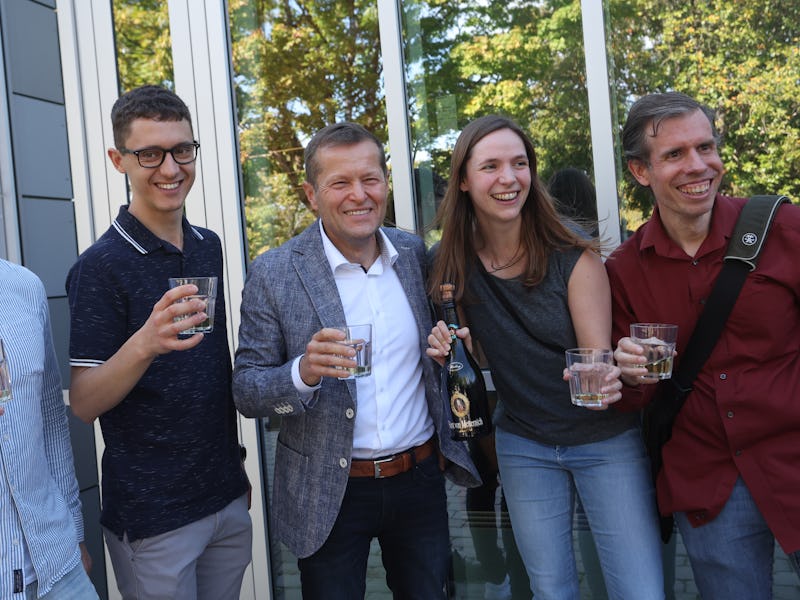This Nobel-Prize Winning Method To Snapshot Electrons Could Revolutionize Modern Computing
Three physicists share this year's Nobel Prize for physics, including the fifth woman ever to win the prize.

The Nobel Physics Prize this year went to physicists Anne L’Huillier, Pierre Agostini, and Ferenc Krausz for developing a way to spy on the ultra-fast lives of electrons.
The physicists’ combined 40 years of work led to a clever way to measure the movements of electrons, which had previously been almost invisible to physicists because of how fast they moved. Their method uses short, fast pulses of laser light — just a few hundred billionths of a billionth of a second long — to take snapshots of where electrons are in their speedy orbits around the center of an atom. It’s like using a high-speed camera and a strobe light to photograph a single beat of a hummingbird’s wings, explains the Royal Swedish Academy of Sciences, the organization responsible for awarding the Nobel Prizes.
L’Huillier, Agostini, and Krausz’s work is key to understanding how individual atoms bond — mostly thanks to electrons — to form complex molecules.
Hungarian-Austrian physicist Ferenc Krausz speaks after the announcement of the winners of the 2023 Nobel Prize in Physics at the Max-Planck Institute in Garching, on October 3, 2023. Three atomic physicists, France's Pierre Agostini, Hungarian-Austrian Ferenc Krausz and French-Swedish Anne L'Huillier, won the Nobel Physics Prize for research into tools for exploring electrons inside atoms and molecules. (Photo by CHRISTOF STACHE / AFP) (Photo by CHRISTOF STACHE/AFP via Getty Images)
Spying on Electrons
Electrons move fast – their movements and interactions happen in attoseconds: a billionth of a billionth of a second.
“An attosecond is to one second as one second is to the age of the universe,” explained the Royal Swedish Academy of Sciences in its press announcement. Until L’Huillier, Agostini, and Krausz’s work, physicists studying electrons could see clouds of blurry motion as electrons zipped around the heavier center of atoms, but they couldn’t track the movements of individual electrons because those movements just happened too fast.
But with the new Nobel laureates’ combined work, it’s now possible to use super-short pulses of light from a laser to measure the tiny slices of time in which electrons move. That makes it possible for physicists to study the complicated sequence of movements and bonds that turn atoms into molecules. Eventually, according to L’Huillier, Agostini, and Krausz, it may help build better semiconductors and improve medical diagnostics.
L’Huillier found the first piece of the puzzle in 1987, when she discovered that when you shine a laser beam into a cloud of certain gases — called noble gases because they don’t react with other chemicals — the light gives some electrons in the cloud an energy boost, making them glow.
At the time, the shortest possible pulse of laser light was about a femtosecond long, which is a millionth of a billionth of a second. That’s fast enough to track the movements of atoms, with their heavy lumbering nuclei of protons and neutrons, but not electrons.
But L’Huillier discovered that when she shined a laser with a femtosecond wavelength at a cloud of a noble gas like helium or neon, the energy-boosted electrons produced overtones: waves that complete a number of entire cycles for every single cycle completed in the original wave.
“In the right circumstances, the overtones coincide so that a series of pulses of ultraviolet light occur, where each pulse is a few hundred attoseconds long,” explains the Royal Swedish Academy of Sciences.
Fourteen years later, in 2001, Agostini and Krausz (working separately but at the same time) figured out how to measure specific pulses from those ultraviolet overtones, between 250 and 650 attoseconds long. That’s short enough to track the movement of electrons, like using a high-speed camera and a strobe light to take a snapshot of a single beat of a hummingbird’s wing.
An Important Call
When the Royal Swedish Academy of Science tried to tell L’Huillier that she’d won a Nobel Prize in Physics, she declined their call — multiple times. L’Huillier, a professor at Lund University in Sweden, was in the middle of teaching a physics class at the time, she explained during a press conference announcing this year’s award.
“The last half hour of my lecture was a bit difficult to do,” L’Huillier admitted (we suspect that her students probably understood).
L’Hillier, who is just the fifth woman to receive a physics Nobel, shares this year’s award with Agostini and Kraus; the Nobel prize in each category can be awarded to up to three researchers if their work is related. Agostini is a professor at Ohio State University, and Krausz is a professor at Ludwig-Maximilians-Universität München in Germany. (One common critique of the Nobels is that laureates disproportionately come from U.S. or European universities.)
Of course, all three physicists worked with entire laboratories of colleagues, students, and staff to make their discoveries. And that’s another common critique of the Nobels: the prize recognizes only three scientists for the work of dozens or hundreds. The era of lone geniuses laboring independently in their labs has been over for a century, at least.
This article was originally published on